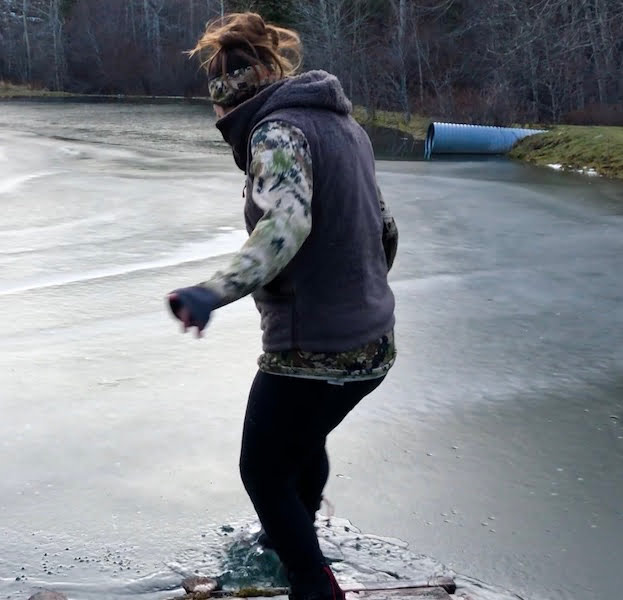
A few weeks ago, I was staring up at the stove pipe opening of the tipi, laying in my sleeping bag, soaking wet in 12-degree weather-for the second time. How do I keep ending up in this situation? Poor friend choices. Just kidding. My friends were in the area and as part of their training, had to partake in a static rewarming drill. The static rewarming drill consists of wearing appropriate clothing and completely submerging in water in sub-32-degree weather, then using one’s body heat to dry out one’s clothes while lying in a sleeping bag. I’m trying to find a clothing system that works and will dry out, so I decided I would do it with them.
Four Years Ago
I was preparing for my first backpack elk hunt. I had the rifle, the backpack, and the desire but I did not have the clothing system. My main concern was staying warm (and snacks because snacks are important while hunting!) Finding clothes was an absolute nightmare, but I finally pieced together a system that I thought would work in the backcountry. I went with First Lite pants with Patagonia base layers, a tank top, and a cowl neck sweater from Cabela’s. For warmth, I had a Kuhl vest. My system has morphed over the years, but I still wear the Kuhl vest-that thing is worth every penny.
How Would My Clothes Work If I Got Wet?
The past couple of years I have had the same clothing system. So, I decided to test it in a static rewarming drill. I’ve always been pretty warm, but I have never gotten wet while hunting, so I had no idea if my clothing would pass the test or not.
The Conditions
It was a cold, overcast November afternoon. The creek fed pond was frozen over and I was a ball of nerves. I was in no way excited to break through the ice in all of my clothes. I hate wearing wet clothes, let alone in below-freezing temperatures.
Standing At The Edge
I was standing at the end of the dock breaking ice with my booted foot, creating a hole to jump through, in Fjallraven tights, Sitka tank top, Sitka Heavyweight Hoody, my Kuhl vest and a Sitka headband, dreading the moment I broke through the water’s surface. One of the guys, A.H., was jumping with me and we made a plan to jump on three. One… Two… Wait wait wait.
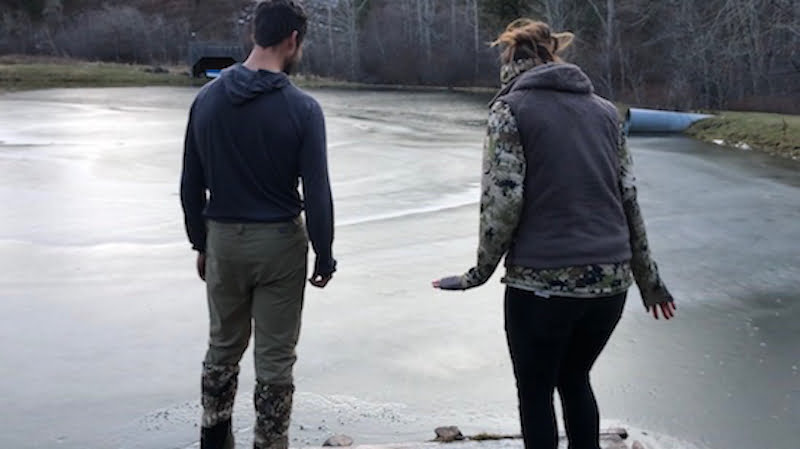
Jumping In
I literally couldn’t make myself jump. A.H. was mentally ready so he gave me a second chance to jump on three-letting me know he was going on three no matter what. One. Two. Three. A.H. actually jumped! Crap. That means I have to jump now. So in I jumped popping up with a screech. Yelling for AH to move faster because he was in my path out, although I was nowhere near him!
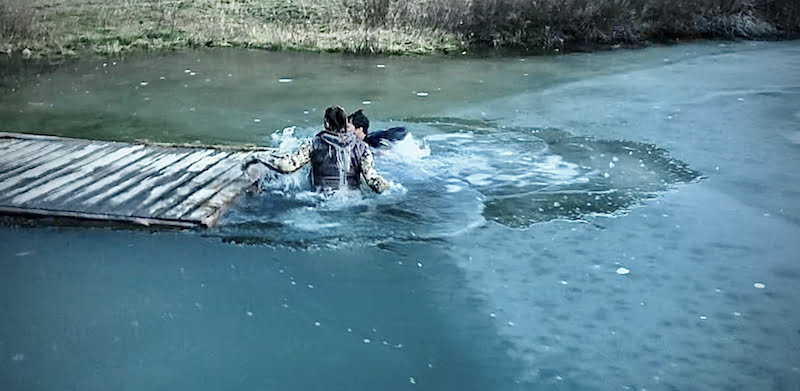
The Static Rewarming Drill
When we finally reached our bags, I noted how soggy my boots were. Thank God I got to take those off. We had to cross a fence and run up the gravel road just a bit to our tipi. Once we cleared the fence, I opened my bag and put on my Sitka Kelvin Active. I was immediately enveloped in a layer of warmth. My hands struggled to coordinate the zipper and were bright red, but I managed. Then I layered my puffy pants and jacket (ECWS level 7). Off to the tipi, I went. Once inside, I stripped off the sopping wet Kuhl vest. It’s fleece and there’s no way it would ever dry. I put my Kelvin Active and puffy jacket back on.
Next we set up the sleeping pads and sleeping bags. As soon as everything was set up, I stripped off my socks and boots and wrapped up in the Kifaru 0 Degree Slick Bag. I was still wet, and uncomfortable, but I was starting to get a little warm. I boiled water for hot water bottles to put inside our sleeping bags while A.H. made hot water for broth and hot drinks.
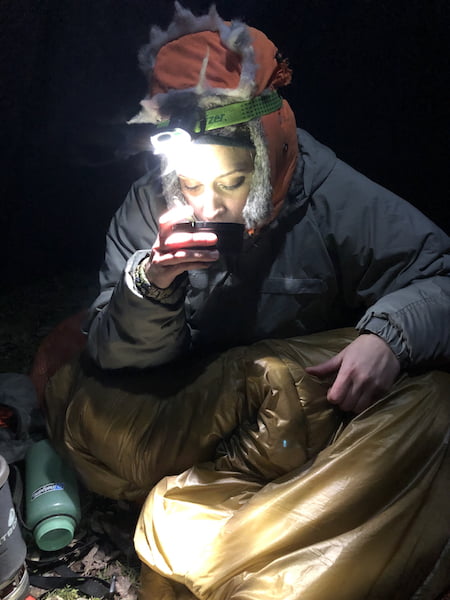
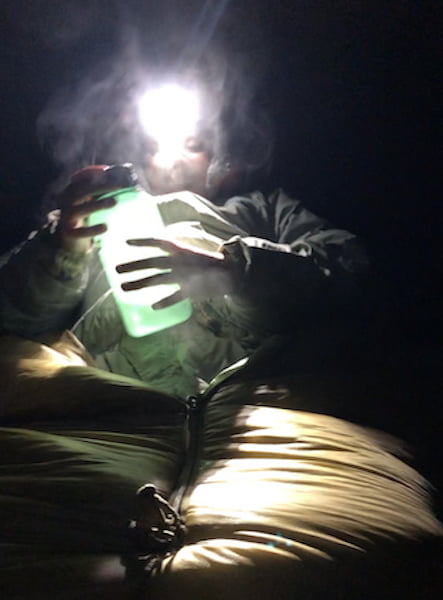
My Rewarming Drill Experience
One would think I’d love this part-laying around eating and bs’ing-but I didn’t. We drank broth constantly, ate a load of snacks, and finally wrapped up all the way in our bags. At one-point, A.H. leaned up and asked if I was ok. I had gone from deliriously laughing and joking to silent and in the fetal position. The outside temperature was between 25-30 degrees and I was wet.
I was still wet 2.5 hours into the drill. A.H. had quickly begun to dry out and was getting comfortable. Every layer I had on next to my skin was so wet you could wring water out of it. The overseer decided to call the drill when all of A.H.’s base layers were dry and the chest part of my heavyweight hoody had dried a bit. I learned that the clothing system I was running was not the system to use if there was even a chance I might get wet. I wouldn’t have died but it would have been a miserable night on the mountain.
Obviously, this first attempt at the static rewarming drill was a fail.
So, what did I learn? Let’s go piece by piece through my clothing system.
The main reason the rewarming drill was a fail was that the layers next to my skin stayed sopping wet. My bottom base layer was the Fjallraven Abisko Trekking Tights. I love these tights as they have water-resistant knees and seat and they are decently warm. They are double duty for me because I run them as a base layer and an outer layer. As much as I love to hike in these, they are not what I want to be wearing in a wet environment. They held onto the water and didn’t even remotely start to dry out. However, in most environments, they’d still be my number one choice.
Top Base Layer
My top base layer was the Sitka Women’s Core Active tank top. I’m grateful for this piece of gear. I’ve been hunting many times where it’s freezing in the morning and hotter than Hades in the afternoon. I also like that I don’t have to keep up with a sports bra separate from my base layer (I like to change into Merino layers for sleeping. It’s always interesting to see how quickly I can find my hunting clothes in the morning.) I had high hopes the tank top would perform well, but it didn’t. After 2.5 hours it was just as wet as it was in the beginning. I’m absolutely still going to use this tank top. I like the versatility it provides me with my layers, I just have to be aware of its limitations as well as what environment I’ll be hunting in.
Top Insulating Layer
On top of the Sitka Core Active tank top, I wore Sitka Women’s Heavyweight Hoody. Sitka really thought out their women’s line and this hoody is proof. I love the built-in pull over finger mitts/ninja gloves and the built-in ninja face mask. It’s soft and really warm. After 2.5 hours inside my sleeping bag, the hoody was about 65% dry. It makes me wonder if the hoody would have performed better if the Core Active tank top had pushed the moisture through instead of holding onto it. I’m not giving up this piece of gear quite yet, regardless of the environment. It did start to dry out, it just took a substantial amount of time.
Insulating Vest
Over the tank top and heavyweight hoody, I wore a Kuhl Flight Fleece Vest. Fleece is warm when wet and I knew this going into the drill. I had worn this vest on a rainy, wet hike in Glacier National Park. Even though I was wet it kept me warm so I could continue my search for the elusive moose. I knew this piece of gear was not going to dry out, but I do wear it consistently while hunting and also knew it would seal in some warmth when I took the plunge. I’m willing to carry this vest as a ball of ice later if need be because of its overall performance.
Insulating Jacket
The first piece of clothing I layered on after completely submerging was the Sitka Women’s Kelvin Active Jacket. I immediately noticed how much warmth it provided. It didn’t get a chance to dry out because the layers under it did not perform properly, but it has worked fantastically before and since. The Kelvin Active was a piece of gear I was missing. I use to hike in First Lite’s Artemis Women’s Hoody and Kuhl vest over. While my core stayed warm, my arms would be frozen. The Kelvin Active keeps my arms warm without overheating my core on hikes. It seems to have a wide range of comfortable temperatures and I find this to be the most versatile piece of gear I have used.
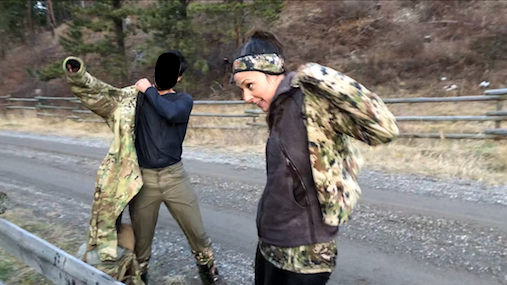
Outer Layer
The outermost layer was the ECWS Level 7 puff suit. This incorporates PrimaLoft synthetic insulation. I use this puff suit for durability and warmth. There are more modern options, but they do not feature the warmth or durability and if they do, they aren’t conducive for backpack hunting as far as weight and packability. I also like not worrying about water messing up the loft of this puff suit.
Insulated Sleeping Pad
Just as important as the clothing system, is a good sleep system. You want to be up off the cold ground with an insulated pad and a nice warm sleeping bag. I used the EXped Synmat HL LW. It has an R-value of 2.9 and goes down to 26.6 degrees Fahrenheit. It was easy and fast to inflate using the schnozzle, which is important when you’re freezing cold and wet and you just want to get in your bag! But 2.9 R-value is definitely not a high enough insulation value for below 30 degrees for me. I had a higher R-value sleeping pad, but the Wyoming winds tangled it up in barbed wire, so it is out of commission.
Sleeping Bag
After the sleeping pad was sufficiently inflated, I slipped into the Kifaru 0 Degree Slick Bag. I’ve slept in this bag a couple of times in the back of the truck. I sleep really cold, so a 0-degree bag in 30-degree weather is decently warm especially with a hot water bottle down by my feet (I know I’m crazy. I swear I produce no heat, so I need a warmer bag than what the outside temperature calls for.) The bag performed well and kept what heat I was producing trapped inside while allowing the water to push through the layers and gather on the outside of the bag.
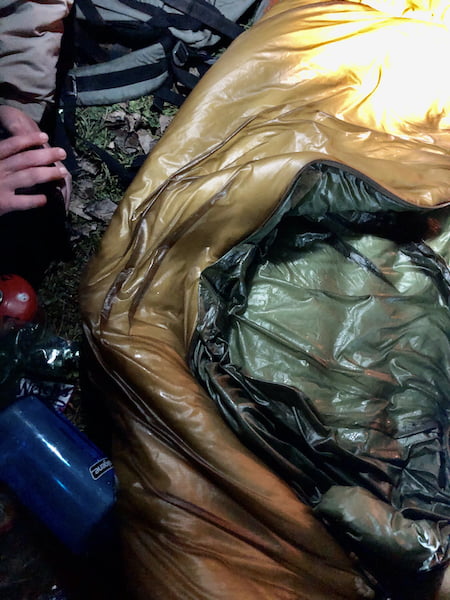
Static Rewarming Drill Failed
At just over 2.5 hours when the event was stopped, I was still soaking wet. The main contributors to my discomfort were the Core Active Tank Top and the Fjallraven tights. These two items failed to push the moisture through to the other layers and instead held it right next to my skin. In a good system, the base layers will remove water from your skin and push it through to the next layers. If the layers next to your skin are dry, your body will start to warm up and help create heat to continue pushing the moisture out.
What Next?
At this point, I have to make changes to my system and repeat the static rewarming drill- specifically base layers, pants, pad, and see if there is a different option for puff suits… But the real question is- can females even produce enough body heat for this to work?
You can comment on this article or ask Rachel questions here.
You may also be interested in these clothing reviews from some of our other writers.
- Sitka Women’s Core Baselayers, By Tanya Avery
- Women’s Sitka Gear, By Jordan Budd
- Kryptek Women’s Line, By Andrea Bertrand
- First Lite Alturas Women’s Guide Pant, By Jordan Budd


















